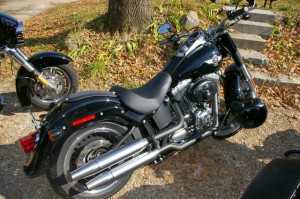By Steve Smith of RIDE-CT.com
 Ever drop a motorcycle? Drops are a not to be confused with a crash. What I’m talking about is a mishap that occurs from a standstill or while riding slowly. Gravity takes over and leads to an “Oh, Shit!” moment. If this has happened to you, you are not alone.
Ever drop a motorcycle? Drops are a not to be confused with a crash. What I’m talking about is a mishap that occurs from a standstill or while riding slowly. Gravity takes over and leads to an “Oh, Shit!” moment. If this has happened to you, you are not alone.
When I began participating with a certain motorcycle owners group Internet forum many years ago, I noticed that there were enough posts about riders dropping their rides that a section dedicated to “Droppers Anonymous” was created. This became the place to confess the details of the event, which usually makes the person feel better about the embarrassing moment or at least gives everyone else a good chuckle.
Most times, a drop occurs while parking the bike, when riding slowly or when performing slow-speed maneuvers. Being aware of the road conditions and surroundings can go a long way to prevent a drop. Being under the influence is another huge factor, but I’m not going to cover that now since we all know about the importance of riding unimpaired by alcohol or drugs.
Here are some things to remember that will help prevent a tip-over when parking a motorcycle:
– Before riding into the place you plan to park, be sure it is safe to do so and note any irregularities that may cause problems. An unnoticed low or sunken storm drain underfoot can cause a rider to lean over farther that expected or catch them off guard.
– When along a curb position, park the motorcycle with the rear wheel to the curb. This  will allow an easier exit since most motorcycles do not have a reverse gear and pushing a motorcycle backwards can lead to foot slipping out and the bike toppling over.
will allow an easier exit since most motorcycles do not have a reverse gear and pushing a motorcycle backwards can lead to foot slipping out and the bike toppling over.
– Park the motorcycle in first gear to prevent it from rolling, particularly when on an incline.
– When using the side stand, turn the handlebars fully to the left for added stability and  lock the forks for security.
lock the forks for security.
– Pay attention to the side stand or center stand. The feet of both can sink onto soft surfaces, such as sand, grass, or even hot asphalt, causing the motorcycle to fall. To prevent this, carry a side stand puck or similar rigid object to put under the stand.
Another likely time for a tip-over is while riding slowly. This occurs with experienced riders as much as the novices. When riding at speed the spinning wheels aid in stabilizing the motorcycle and keeping it upright due to gyroscopic effect. This stabilizing action is almost nonexistent while riding slowly and makes is all that much easier to lose balance, especially with larger, heavyweight touring motorcycles.
Once the motorcycle teeters off center the rider must put a foot down to correct and straighten the bike. If it teeters too far off center, the angle may be too much and the weight too great for many riders to right the motorcycle with one leg, and down she goes. So:
– Do not abruptly apply the front brake while riding slow with the handle bars turned.
– When coming to a stop, make sure the motorcycle is upright and the handlebars are square.
In the unfortunate event of a drop, many riders hastily try to pick up the bike quickly to minimize the embarrassment time. This can lead to injury, if not just a hurt back. Instead:
– Step back for a moment and assess the situation. Are there any injuries? It is safe to attempt to right the motorcycle where it lies? Will you really be able to do it by yourself?
– Use the engine cut off switch to make sure the engine is off and wheel is not under power.
– Prevent the chance of a fire and do not smoke or ignite any flames. Check if gasoline leaked or is still leaking out the bike.
– The motorcycle should be in gear to prevent rolling as you are attempting to lift.
– Do not try to raise the bike up an incline. This requires more effort and further lifting distance to right the motorcycle. Reposition the motorcycle for easier lifting, preferably to flat ground.
– When possible, make sure the side stand is extended before lifting the bike.
– If available, get help. Even when using proper lifting technique it is much easier, and there is less chance of injury and further damage to the bike with more hands.
At 5′ 3″, weighing in at 118 lbs with boots, Carol “Skert” Youorski is well known as the petite woman who teaches other woman to lift a heavy motorcycle. The key is leverage and lifting only with the legs. With your lower back against the seat and legs fully bent at the knees, hold tight onto the low side handlebar with one hand and the frame in the other. Keeping your back straight, begin walking backward and lifting upward with your legs until the bike is upright. Skert provides directions on her website or you can view this video that was produced by some other riders.
 Ride CT & Ride New England Serving New England, NYC and The Hudson Valley!
Ride CT & Ride New England Serving New England, NYC and The Hudson Valley!


